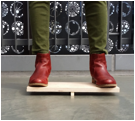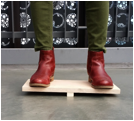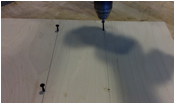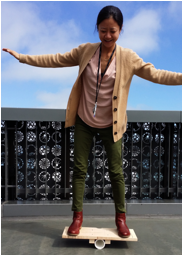Balance Boards
 Wednesday, September 9, 2015 at 06:25PM
Wednesday, September 9, 2015 at 06:25PM
Over Your Feet
for a Science of Dance workshop
Things don’t fall when their center of mass is over their base
Recommended Grade Level: 6 to 12
NGSS Science & Engineering Practices
• Asking questions and defining problems
• Developing and using models
• Planning and carrying out investigations
Time: 30 minutes in class, 2 hours to make the first time
Materials Needed
(per group)
- 3 12 x 24 x ¾ inch plywood boards
- 1 x 12 x ¾ inch plywood strip (You may be inclined to use some other wood, but plywood is especially resistant to splitting.)
- ½ x 12 x ¾ inch plywood strip
- 8 1 ½ inch drywall or wood screws
- 12 inches 2 or 2 ½ inch PVC pipe
- 24 inches 2 x 2 inch (actually sized 1 ½ x 1 ½ ) cut into two 12 inch pieces
Background Information
When dancers balance they need to keep their center of mass over their feet. When they are on they are on their toes or hands, this becomes especially hard since the area is much smaller. This is a way for non-dancers to get a sense of how difficult that is and is similar to a way that some dancers practice.
To Do and Notice
1. Attach the 1 inch wide strip of plywood to the center of one of the plywood boards using drywall or wood screws. Drilling 1/8 inch pilot holes in the strip before you put in the drywall or wood screws will greatly decrease the risk of splitting the strip. Using wood glue along with the screws will make a stronger, longer lasting joint. Twist the screws enough to set them below the surface to avoid marking you floors. Repeat with the ½ inch strip.


2. Try to balance on one board then the other. How are the two boards different?


If you need to save space, you can build a single balance board with one strip on each side.

3. What are you doing to keep your balance? If you use the expression “shifting your weight”, what do you actually mean by this in a physics or biomechanics sense?
4. Time to build the last balance board. Find the center of the third board. Place the PVC pipe in the center. Space the two 2x2’s so that they hold the pipe in place. Mark the edges of the 2x2’s on the board. Flip the board over and drill two 1/8-inch pilot holes for each of the 2x2’s. Screw in the drywall or wood screws from the topside into the 2x2’s. It won’t hold the PVC pipe from falling out, but it will keep it from rolling.



5. Have a person try to balance on the PVC pipe board. Most will find it much more difficult. Why is it harder?
What’s Going On?
·  To maintain your balance you need to keep your center of mass over your base. The wider base is easier since it gives you more chance for error than the narrower base. Once you get your center of mass at rest over the base, you will stay balanced as long as your center of mass stays there. This is called “passive stability”.
To maintain your balance you need to keep your center of mass over your base. The wider base is easier since it gives you more chance for error than the narrower base. Once you get your center of mass at rest over the base, you will stay balanced as long as your center of mass stays there. This is called “passive stability”.
· The pipe is much harder to keep your balance on because its “base” is very, very small, so there is virtually no way to keep your center mass over the base. You will be on one side of the base or the other, and you will have to move actively your center of mass back and forth. This is called “active stability”.
· Dancers have to maintain their balance over their feet. So since she extended her right leg and to a smaller extent her right arm, she needs to lean to her left to make sure that her center of mass stays over her feet. Notice that her left arm is straight up. Why doesn’t she want to extend it away from her body (to her right) like her left arm?
Going Further

Surprisingly, you can make the pipe board harder to balance on by making the pipe smaller. If you make the board with ¾ inch PVC pipe instead of 2 ½ inch, it will be the same height as the other balance boards. And it will be nearly impossible. There are several reasons why it is more difficult but the main one is distance and time. With a smaller diameter pipe, the board end of the board will be closer to the floor, meaning that it will touch sooner. This gives you less time to correct for being off in your balance.
References
Ballet picture by Harclade, Used with Permission.
https://www.flickr.com/photos/harclade/5932310173/in/set-72157626955587005/


Reader Comments